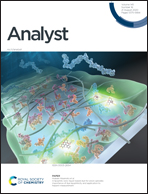A potentiometric sensor based on modified electrospun PVDF nanofibers – towards 2D ion-selective membranes†
Abstract
Core–shell modified nanofiber mats were used as ion-selective membranes for the first time. Keeping the overall macroscopic size of the sensing element the same as for classical plasticized poly(vinyl chloride) membranes, herein the proposed nanofiber based systems resulted in ultrathin (<10 nm) recognition layers with the total area nearly 3 orders of magnitude larger and the surface to volume ratio close to 7.5 × 107. Thus, for the first time close to 2D potentiometric receptors were obtained. Formation of thin and continuous liquid recognition layers on nanofibers was confirmed by XPS studies. The nanofiber based ion-selective mats used in the classical internal-solution arrangement were characterized with analytical parameters – the slope and detection limit well comparable to those for classical plasticized poly(vinyl chloride) based membranes. Despite the novel arrangement of the ion-selective layer and its nanometric thickness, the reproducibility of the recorded potentials, studied for more than 30 days, was high. Using confocal microscopy it was shown that electrolyte transport through porous nanofibers’ mat phase is the rate limiting step in conditioning of the receptor layer. The estimated electrolyte diffusion coefficients for the nanofiber phase are close to 10−10 cm2 s−1, and thus are orders of magnitude lower compared to values characterizing ion transport through classical poly(vinyl chloride) based membranes. The truly nanostructural character of nanofiber ion-selective mats is visible in chronoamperometric experiments. It was shown that a core–shell nanofiber mat behaves as an array of nanoelectrodes – individual nanofibers. Thus, the novel nanofiber based architecture of ion-selective mats brings also a new quality to the current based electrochemistry of ion-selective sensors.



 Please wait while we load your content...
Please wait while we load your content...